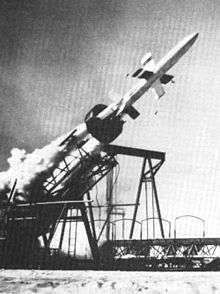SAM-N-2 Lark
The Lark project was a high-priority, solid-fuel boosted, liquid-fueled rocket surface-to-air missile developed by the United States Navy to meet the kamikaze threat.[2] After Lark configuration was established by the Bureau of Aeronautics in January 1945 Fairchild Aircraft was given a contract to produce 100 missiles in March 1945. Fairchild used radio command guidance with a semi-active radar homing AN/DPN-7. A backup contract for another 100 missiles was given to Convair in June 1945. Convair used beam riding guidance with AN/APN-23 active radar homing.[3] Neither version was successful. Six of the Convair airframes were given to Raytheon to explore use of velocity-gated continuous wave doppler radar for guided missile target seekers, while most other United States investigators used range-gated pulse radar. One of these Raytheon guidance systems in a Convair airframe scored the first successful United States surface-to-air missile interception of a flying target in January 1950.[2]
| Lark | |
|---|---|
 This SAM-N-2 Lark missile airframe is preserved at the Point Mugu Missile Park near Naval Air Station Point Mugu. | |
| Type | Surface-to-air missile |
| Place of origin | United States |
| Production history | |
| Manufacturer | Fairchild Aircraft Convair Raytheon |
| Produced | 1946-1950 |
| Specifications | |
| Mass | 920 kilograms (2,030 lb) missile: 550 kilograms (1,210 lb)[1] booster: 370 kilograms (820 lb) |
| Length | 18 feet 6 inches (5.64 m) missile: 13 feet 11 inches (4.24 m) booster: 4 feet 7 inches (1.40 m) |
| Diameter | 18 inches (46 cm)[1] |
| Warhead | 100 pounds (45 kg) high-explosive warhead |
Detonation mechanism | proximity fuze |
| Engine | Stage1: solid-fueled rocket booster, Stage2: liquid-fueled rocket |
| Wingspan | 6 feet 3 inches (1.91 m)[1] |
Operational range | 55 kilometres (34 mi) |
| Maximum speed | Mach 0.85 |
Guidance system | initially radio command |
Launch platform | USS Norton Sound (AVM-1) |
Early guided missile development

The Lark never proceeded past the prototype stage. Further Lark development was halted by the Bureau of Ordnance in late 1950 in favor of the RIM-2 Terrier being developed by Operation Bumblebee. A subsonic missile was of doubtful use against anticipated supersonic targets; but three successful Lark interceptions by the Raytheon guidance system[2] generated interest within the Army and Air Force. Modified Larks were used for guidance system development testing by all three services through the early 1950s.[3] The Bureau of Aeronautics Sparrow program began in 1950 using the Lark target seeker in air-to-air missiles.[2] The Army used Lark components investigating guidance options for the MGM-18 Lacrosse surface-to-surface missile. Changing roles during a period of changing nomenclature created a confusing number of designations for Lark. Fairchild production was identified as KAQ, SAM-N-2, and CTV-N-9. Convair production was identified as KAY, SAM-N-4, and CTV-N-10. Army test versions were designated RV-A-22.[3]
References
- "Lark". Smithsonian Air and Space Museum. Archived from the original on 2011-04-29.
- Peck, Merton J. & Scherer, Frederic M. The Weapons Acquisition Process: An Economic Analysis (1962) Harvard Business School pp.232-233&659
- "SAM-N-2/SAM-N-4". Andreas Parsch. Retrieved 2013-04-17.